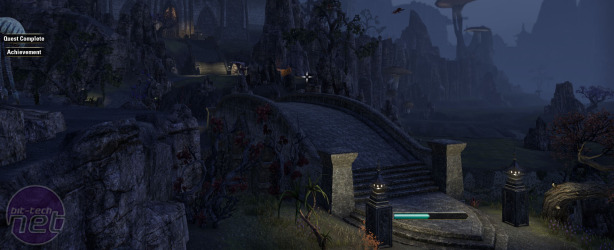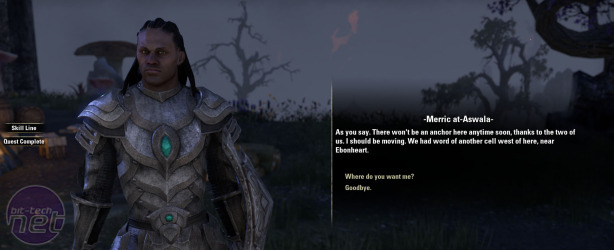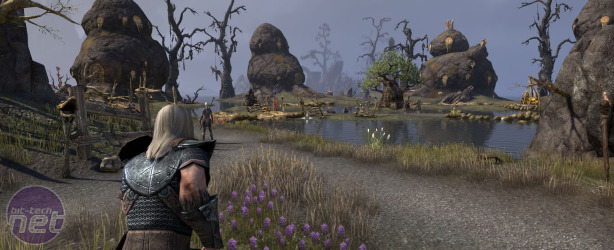
The wisdom of building an MMO around what feels a lot like a solo Elder Scrolls experience also must be questioned. The game explicitly bangs on about how important you are, but this is impossible to believe when enemies respawn just a couple of minutes after you killed them, and your achievements in defending cities and completing quests has no discernible effect on the world around you (sometimes it does, but it's inconsistent to say the least). Moreover, this isn't an Elder Scrolls game in which you adventure with your friends, its one where you adventure alongside your friends, following the same path and completing the same stories, but never really feeling like a party, a troupe.
The flipside of this is, it is nice to play an Elder Scrolls game in which other people are running around, even if it's ultimately in a parallel universe overlaid upon your own. And of course there are various events such as raids and rifts (in the form of huge "anchor" portals that dominate the Tamriel skyline) for which it's advisable to bring a friend along. Plus, if you're in a dungeon with another player, you might as well team up for the purposes of combat.
Speaking of which, combat is another mixed bag. TESO's class system is one of its most successful features, with a variety of classes for each race and faction that are open-ended in terms of how you tailor your abilities. We picked a Nord Dragonknight, and opted for dual melee weapons as the primary method of engaging enemies. Combat is fast and frenetic, with slick animations and some dazzling spell effects. But melee attacks are sorely lacking in any sense of impact, to the point where it can feel like you're just wafting your weapons in front of the enemy, as if you're inviting them to smell a freshly-baked pie.
That said, the combat system does allow you to develop your own tactics for dealing with different situations. For example, the DragonKnight has a "stonefist" ability which knocks down enemies and interrupting their attacks, useful for disabling one enemy while focussing your attack on another. Later on you can unlock a "Dragon Leap" ability that enables you to initiate combat by leaping in the air and pummelling the ground, damaging all nearby enemies. This is handy for literally getting the jump on large groups of enemies or dungeon bosses, although it's a little buggy at the moment, not always initiating the jump. Like so much else in the game, combat gets better as the game ups the ante and you unlock access to more and better abilities. But this is only because the core design feels lacklustre, and needs to be rescued by that later variety.
While we spent most of our time exploring the PvE areas, we did dip into Cyrodiil for a spot of PvP action, and here the game has a lot of potential. The entire of Cyrodiil is a PvP area, stuck in a three-way war between the factions as they vie for control of the Elder Scrolls themselves, which are houses in temples dotted around the map. Each temple is protected by two fortresses, which in turn are supplied by nearby farmsteads and so forth. To capture an Elder Scroll, the faction must successfully besiege both fortresses before assaulting the Temple.
There are various ways you can help the cause of your faction, whether by manning a siege engine to batter down the walls of a fortress, or rain down fire on an invading enemy. Or you can take on a specific mission such as scouting an enemy fortress or taking on the bounty of a specific player. These different elements mean you can join in the PvP however you like, working alone, in small groups and raiding parties, or dive straight into the largest battles you can find. It's big enough and complex enough to produce some interesting stories. For example, while defending a fortress against a vastly superior enemy, one player took it upon himself to lead the defence, and convinced all the other defenders to hide inside the fortress, and ambush the opposing side as they entered the fortress.
TESO's PvP element could well turn out to be the most interesting aspect of the game, but it's almost certainly not the reason people will be planning to invest in it, which brings us back to the PvE side. Although TESO takes a preposterously long time to reach anything like a level of quality that would make it worth the subscription Bethesda are planning to charge, the quality does gradually improve. Around the level ten mark the quests had become more elaborate and involved, with higher stakes and better rewards. What's more, the writing had improved, and the game had opened up to greater levels of exploration, with more dungeons to explore and hidden treasures that actually made them worth delving into.
The Elder Scrolls Online is still not exactly the game that many Elder Scrolls fans wanted. The MMO model exacerbates some of the Elder Scrolls' worst traits while curtailing its best. But the world of Tamriel remains extremely alluring and toward the end of our time with it its trajectory was definitely on the way up. If the game continues to improve in that manner, and Zenimax can add some weight to the combat and take a pair of scissors to the ponderous introduction, it's just possible that Bethesda have got something.
The flipside of this is, it is nice to play an Elder Scrolls game in which other people are running around, even if it's ultimately in a parallel universe overlaid upon your own. And of course there are various events such as raids and rifts (in the form of huge "anchor" portals that dominate the Tamriel skyline) for which it's advisable to bring a friend along. Plus, if you're in a dungeon with another player, you might as well team up for the purposes of combat.
Speaking of which, combat is another mixed bag. TESO's class system is one of its most successful features, with a variety of classes for each race and faction that are open-ended in terms of how you tailor your abilities. We picked a Nord Dragonknight, and opted for dual melee weapons as the primary method of engaging enemies. Combat is fast and frenetic, with slick animations and some dazzling spell effects. But melee attacks are sorely lacking in any sense of impact, to the point where it can feel like you're just wafting your weapons in front of the enemy, as if you're inviting them to smell a freshly-baked pie.
That said, the combat system does allow you to develop your own tactics for dealing with different situations. For example, the DragonKnight has a "stonefist" ability which knocks down enemies and interrupting their attacks, useful for disabling one enemy while focussing your attack on another. Later on you can unlock a "Dragon Leap" ability that enables you to initiate combat by leaping in the air and pummelling the ground, damaging all nearby enemies. This is handy for literally getting the jump on large groups of enemies or dungeon bosses, although it's a little buggy at the moment, not always initiating the jump. Like so much else in the game, combat gets better as the game ups the ante and you unlock access to more and better abilities. But this is only because the core design feels lacklustre, and needs to be rescued by that later variety.
While we spent most of our time exploring the PvE areas, we did dip into Cyrodiil for a spot of PvP action, and here the game has a lot of potential. The entire of Cyrodiil is a PvP area, stuck in a three-way war between the factions as they vie for control of the Elder Scrolls themselves, which are houses in temples dotted around the map. Each temple is protected by two fortresses, which in turn are supplied by nearby farmsteads and so forth. To capture an Elder Scroll, the faction must successfully besiege both fortresses before assaulting the Temple.
There are various ways you can help the cause of your faction, whether by manning a siege engine to batter down the walls of a fortress, or rain down fire on an invading enemy. Or you can take on a specific mission such as scouting an enemy fortress or taking on the bounty of a specific player. These different elements mean you can join in the PvP however you like, working alone, in small groups and raiding parties, or dive straight into the largest battles you can find. It's big enough and complex enough to produce some interesting stories. For example, while defending a fortress against a vastly superior enemy, one player took it upon himself to lead the defence, and convinced all the other defenders to hide inside the fortress, and ambush the opposing side as they entered the fortress.
TESO's PvP element could well turn out to be the most interesting aspect of the game, but it's almost certainly not the reason people will be planning to invest in it, which brings us back to the PvE side. Although TESO takes a preposterously long time to reach anything like a level of quality that would make it worth the subscription Bethesda are planning to charge, the quality does gradually improve. Around the level ten mark the quests had become more elaborate and involved, with higher stakes and better rewards. What's more, the writing had improved, and the game had opened up to greater levels of exploration, with more dungeons to explore and hidden treasures that actually made them worth delving into.
The Elder Scrolls Online is still not exactly the game that many Elder Scrolls fans wanted. The MMO model exacerbates some of the Elder Scrolls' worst traits while curtailing its best. But the world of Tamriel remains extremely alluring and toward the end of our time with it its trajectory was definitely on the way up. If the game continues to improve in that manner, and Zenimax can add some weight to the combat and take a pair of scissors to the ponderous introduction, it's just possible that Bethesda have got something.

MSI MPG Velox 100R Chassis Review
October 14 2021 | 15:04













Want to comment? Please log in.